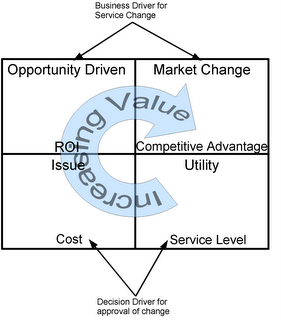Pay per use. Capabilities are charged using a metered, fee-for-service, or advertising based billing model to promote optimization of resource use. Examples are measuring the storage, bandwidth, and computing resources consumed and charging for the number of active user accounts per month. Clouds within an organization accrue cost between business units and may or may not use actual currency.
This is the real shift in computing and IT. Not the virtualisation, not the development environments but the shift towards a utility pricing solution. I notice the last line appears to have been tacked on as it doesn't fit the previous piece so much. If a transaction isn't using currency units then how on earth is it "pay"?
Business centric SOA represents that shift towards an economic approach to computing, it enables companies to understand where different forms of economic model work and the value that IT can bring. Cloud sits where IT becomes a pure utility, non-differentiating and available on demand. While at the moment these can be pitched as "value" elements that is simply because we are moving from a cottage industry of servers on racks towards an industrialised power supply business. Today we all run little mills by the river, cloud provides us with the power on demand to scale to ever larger demands. This does not mean however that cloud will differentiate us from our competition but our ability to use these new ways of work can.
Taking a business centric SOA look at IT and understanding the heatmap to focus people and understanding the value is about that shifting focus towards economic models which then allow you to understand where you invest and where you commoditise.
Clouds are not about value creation, they should be a low cost tool that enables you to create value from them. Equating the value with the tool is wrong, it is the application from which the value comes. Having a "cloud" does nothing, except reduce cost, unless you then work in other ways. To use the mill analogy, one company could take the new electricity supply and just run the old mill cheaper without the maintenance costs of the wheel and the issues with drought, another could use it to change the location to be nearer a larger population centre and away from the flood plain and devise a production line that creates the product for 1/3 the price. In both cases the utility is the same and in both cases it reduces a cost, in one however someone has learnt how to use the new low cost tool to drive new value for their business.
Economic models for IT are going to become more and more important in the next 10 years and understanding them, and making sure you are on the right side of them, will be very important for IT professionals who want a decent career.
Technorati Tags: SOA, Service Architecture
